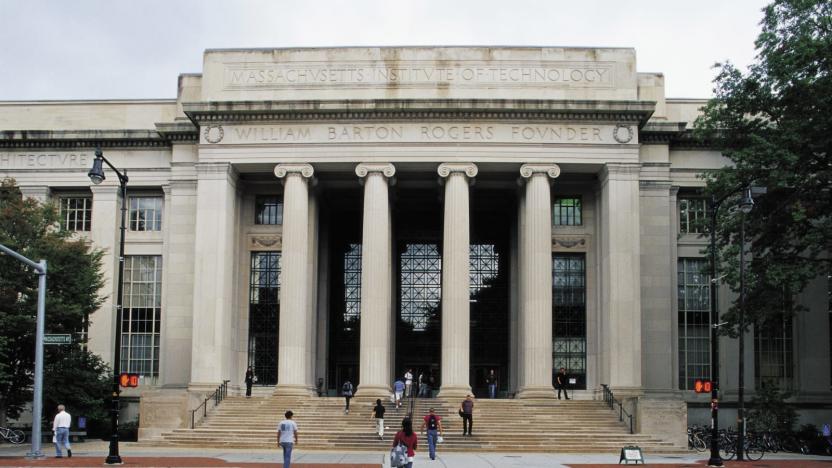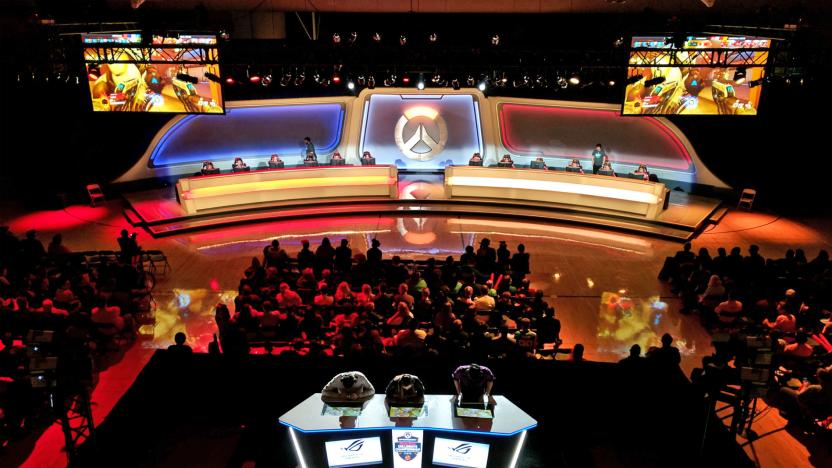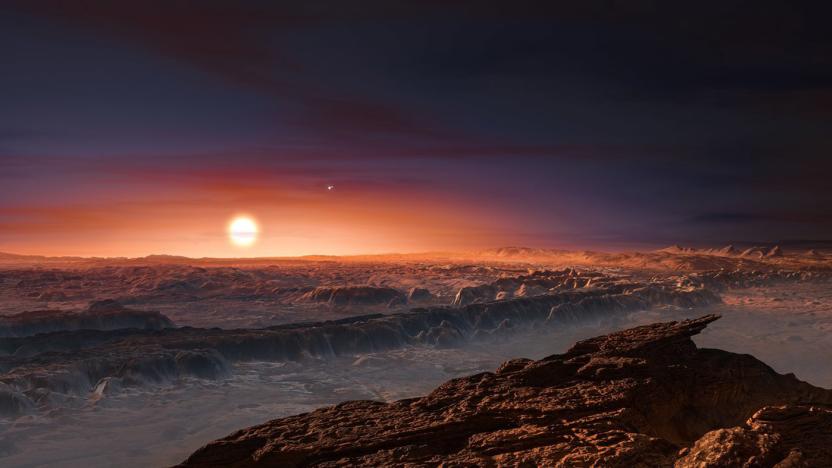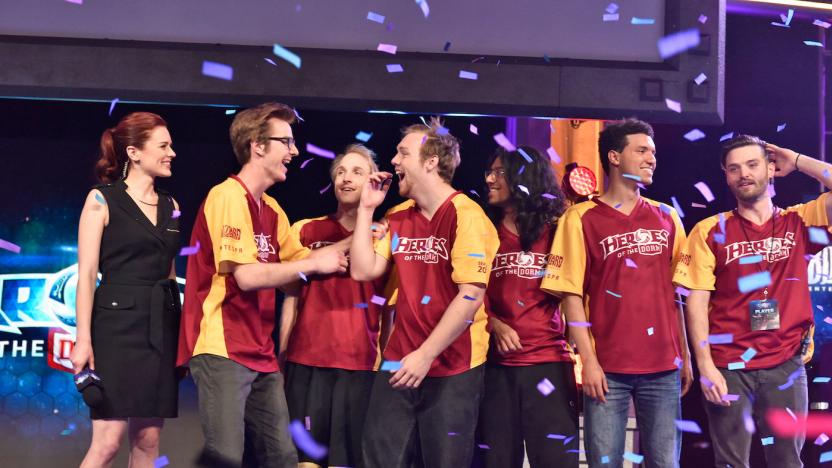ArizonaStateUniversity
Latest

Uber is offering free college to its top drivers
Uber is offering the cost of college tuition for its top drivers or their families as part of its new Uber Pro program. Drivers will also be able to claim other perks including cash back on fuel purchases and discounted car maintenence costs. The program is launching in just a handful of markets starting today.

Amazon's Alexa Fellowship expands to 14 more universities
Amazon is eager to get more bright minds working on voice technology, so it's expanding the Alexa Fellowship program to 14 more universities, including Massachusetts Institute of Technology, Texas A&M and Cambridge. The fellowships are financed through Amazon's $200 million Alexa Fund.

College esports is set to explode, starting with the Fiesta Bowl
As executive director of the Fiesta Bowl, one of the largest postseason college football games of the year, Mike Nealy was more familiar with shoulder pads than mousepads. Six months ago, he didn't know people were making money playing video games professionally, he'd never heard of Twitch, and the last time he picked up a controller, it was attached to an Atari 2600. That all changed after a conversation with John Pierce, an esports consultant and former marketing head for the Phoenix Coyotes and US Olympic Committee. Pierce outlined the professional-gaming boom to Nealy and explained how it could tie into the collegiate football scene. He put Nealy in touch with Blizzard, the studio behind Overwatch.

Mini-Hubble will scan dim stars to see if they can support life
It doesn't take hugely expensive space telescopes like the Hubble and future James Webb Space Telescope to hunt for habitable exoplanets. NASA and the University of Arizona will launch a small telescope the size of a cereal box called the Star-Planet Activity Research CubeSat, or SPARCS, in 2021. The aim is to find so-called M Dwarfs, stars 20 times dimmer than our sun, and see if they emit too much radiation to support life on other worlds.

NASA is crowdsourcing the search for exoplanets
To those of you who dream of going to space: Sorry, but that may never happen. However, NASA is once again counting on the public for help understanding what's beyond our world. All we have to do is look at some photos online. Today marks the launch of Backyard Worlds: Planet 9, a project that relies on everyday people to help scientists identify objects near our solar system. These celestial bodies appear to move across the sky, but computers have a hard time finding things like brown dwarfs and planets in the noisy images. This means manually searching the photos is the most effective method to get the job done.

New algorithm performs complex DNA origami
Researchers from MIT, Arizona State University and Baylor University have developed a new algorithm that promises to simplify the arduous and complex task of assembling DNA into structures other than a double helix. These structures could eventually be used as everything from DNA storage modules to delivery vehicles for CRISPR enzymes and other medicines, but until now the process of creating them has been prohibitive.

Arizona State University wins 2016's 'Heroes of the Dorm'
Arizona State University's "Real Dream Team" won't have to pay for tuition for the rest of the time they're enrolled. How's that? Over the weekend these runners up from last year's premiere Heroes of the Dorm competition beat out rivals from UConn and the University of Texas at Arlington in Heroes of the Storm, where top prize is gratis education. Before you start wondering if they can repeat this, maybe give the guys a break and let 'em bask in the victory of not only free college, but of their eSports exploits being broadcast in primetime on ESPN 2.

Batteries that stretch are perfect for smart watches and clothes
Used to be that the only time your lithium-ion batteries changed their shape was when they were about to explode in an airliner cargo hold. But thanks to the ingenuity of an Arizona State University research team, future power packs could not only bend but stretch up to 150 percent of their original size while providing an uninterrupted stream of power. Their secret: the ancient Japanese art form of Kirigami. It's an offshoot of the more well-known Origami form that involves both folding and cutting the working material.

GE partners with Livermore Labs to explore efficient aircraft fuel injectors (video)
What would you do with six months of dedicated access to 261.3 teraflops of computational power? As you ponder that question, consider the case of GE Global Research, which has just announced its participation with the Lawrence Livermore National Laboratory in an effort to design more powerful and efficient aircraft engines by way of computer simulation. Specifically, GE will partner with researchers from Arizona State University and Cornell University to study the unsteady spray phenomena that's thought to be ideal for fuel injectors. Through Large Eddy Simulation, GE hopes to discover an ideal spray pattern and fuel injector design, and reduce its number of lengthy, real-world optimization trials. While the research is initially aimed at aircraft engines, the knowledge gained from these experiments may work its way into GE's other products, such as locomotive engines and land-based gas turbines. For a glimpse into GE's current research, be sure to hop the break.

NASA creates high-res Moon map, taunts you about your terrestrial tethers
Chances are you will never set foot on the Moon. Sorry, we don't mean to rain on your parade (alright, maybe we do), but the closest you'll ever get is looking at pictures or traipsing around Google Moon. NASA's LRO (Lunar Reconnaissance Orbiter) has been circling our rocky satellite capturing such images, and now 69,000 of them have been stitched together to create the highest resolution topographic map of the lunar surface ever. The Global Lunar DTM 100 m topographic model has a scale of roughly 100 meters per-pixel, allowing researchers to better understand how the crust is formed and accurately scout landing sites for future missions -- be they robotic or manned. Check out the source for a larger image and a few more details.

Intel's smart TV remote will recognize you, tailor content to your wishes
It's all about how you hold it, apparently. Intel's Labs have churned out a proposal for a new user-identifying system to be embedded into remote controls. Given a bit of time to familiarize itself with particular users, this new motion sensor-equipped channel switcher is capable of correctly recognizing its holder just by the way he operates it. Taking accelerometer readings every 100 nanoseconds, the researchers were able to build a data set of idiosyncrasies about each person, which would then be applied the next time he picked up the remote. Alas, accuracy rates are still well short of 100 percent, but there's always hope for improving things and for now it's being suggested that the system could be employed to help with targeted advertising -- which is annoying anyway, whoever it may think you are.

New mass-production technique for flexible OLEDs could make them cheap
Getting tired of flexible OLED prototypes that are about as ready for retail as that cold fusion reactor your uncle Harry is building in his garage? Yeah, we are too, but it seems the industry is getting a little closer to reality, the latest step coming courtesy of Arizona State University's Flexible Display Center and Universal Display. Researchers at the pair have managed to produce flexible OLED displays using the same production techniques used to create standard, rather less bendy LCD displays, enabling the transistors that control the pixels to be applied to plastic, rather than the glass they typically find themselves embedded within. They glue a piece of plastic onto glass, feed it through the LCD manufacturing process, then peel the two apart like a high-tech Fruit Roll-Up. That technique was used to create the 4.1-inch monochrome display shown above -- which is for now just another prototype that won't be showing up in any devices any time soon. [Warning: PDF read link][Via Technology Review]

Kindle DX college plans revealed: only 300 students total
We knew the Kindle DX pilot programs at Arizona State, Case Western Reserve, Princeton, Pace, Reed, and Darden School of Business at the University of Virginia would be limited in number, but it sounds like students at those schools will have be extremely lucky or well-connected to get their hands on Amazon's latest -- according to Pace reps at today's launch event, each school will only receive around 50 Kindle DXs for the trial. That's just about 300 total Kindles, and it makes Amazon's crowing about revolutionizing education seem a little hasty. Not only that, but it's not like the program is particularly ready to go, either: the schools still haven't figured out which classes they'll try and switch over to the Kindle, instructors have yet to be brought on board, and it's still not clear whether Amazon or the schools themselves will pay for the Kindles, although students will definitely have to shell out for the books. That's a lot of dealmaking to get done -- looks like Amazon just gave itself some summer homework.

HP and ASU demo bendable, unbreakable electronic displays
Well, what do you know? Nearly four years after Arizona State University opened its very own flexible display center comes this, a prototype device that's purportedly easy to manufactur, easy on the environment and practically as strong as Thor. HP and ASU have teamed up to demonstrate the fresh e-displays, which are constructed almost entirely of plastic and consume far less power than traditional computer monitors. The "unbreakable displays" were crafted using self-aligned imprint lithography (SAIL) technology invented in HP Labs, and while we'd love to see this in a pliable laptop at CES 2009, we suspect it'll be a few years yet before these slither out to the commercial realm.Update: HP Labs pinged us with this tidbit on the image above. "This image from the Flexible Display Center at ASU represents what the flexible display, a paper-like computer display made entirely of plastic, could look like in the future."

Biosensing nanodevice could hasten security checks, health screenings
We'll go ahead and warn you: if you're hoping to purge your mind of all things science this weekend, this post isn't the one to be reading. For the rest of you knowledge seekers, Arizona State University researcher Wayne Frasch has developed a biosensing nanodevice that could possibly revolutionize health screenings and speed up that grueling airport security process. Put simply (well, as simply as possible), he discovered that the enzyme F1– ATPase can be equipped with an optical probe and "manipulated to emit a signal when it detects a single molecule of target DNA." Currently, a prototype of the DNA detector is already being worked up, but there's no word on when (or if) the device will escape the lab and hit the commercial realm. Still not geeked out? Hit the read link and hold on for dear life.[Via Physorg]

Femtosecond laser pulses could safely destroy viruses, bacteria
The world is already well aware of just how potent (and useful) femtosecond lasers are, and a recent study conducted by a team of Arizona State University physicists explains how pulses could be used to dismantle viruses and bacteria without harming a single innocent cell. Rather than follow in the footsteps of indiscriminate laser treatment options, the group of Sun Devils reportedly figured out a way to "produce lethal vibrations in the protein coat of microorganisms," which has the potential to at least treat "blood-borne diseases such as AIDS and Hepatitis." The technique, dubbed ISRS (Impulsive Stimulated Raman Scattering), has shown to not harm healthy human cells while fighting the good fight against viral pathogens, and while there's no easy way to surmise how quickly we'll see this in action, we're gonna wait for a bit more proof before getting our hopes up.[Via Switched]

Terabyte nanotech thumb drives around the corner?
Wired has a write-up of a new storage technology developed at Arizona State University that could produce flash thumb drives capable of storing terabytes of data in the near future, that also happens to be cheaper and more energy efficient than flash memory. The new technology has been branded programmable metallization cell, and differs from present storage technologies in that it "creates nanowires from copper atoms the size of a virus to record binary ones and zeros." It all sounds very interesting -- if slightly too optimistic -- to us, and we'll get to find out relatively soon just how effective the new chips are: Arizona State's business arm has licensed the technology to three companies, which may be ready to sell a product containing the chips within 18 months. Watch this space.

Arizona student envisions giant space mirrors for terraforming Mars
Anyone who's ever read science fiction knows that in addition to space elevators and transporters, there's another futuristic technology that we'd all dig: terraforming. Being able to transform the moon, Mars, or any other barren celestial body into a new Earth would make human interplanetary colonization a bit more feasible. However, instead of terraforming an entire planet, which at current estimates could take centuries, it appears that altering one single square kilometer first might be a bit simpler. Earlier this year, Rigel Woida, an undergraduate at the University of Arizona, received a grant from the NASA Institute for Advanced Concepts to study "reflective balloons," which in theory could raise the surface temperature of Mars on that patch to 68 degrees Fahrenheit (20 degrees Celsius), compared with the typical high of -76 degrees Fahrenheit (-60 degrees Celsius). Woida recently gave a presentation at the NAIC meeting in October and will give another at a second meeting this March, where he will hopefully show NASA how great his concept his, and how the astronauts who study Mars in his little patch of paradise will be able to like, totally, get the best tan ever.










